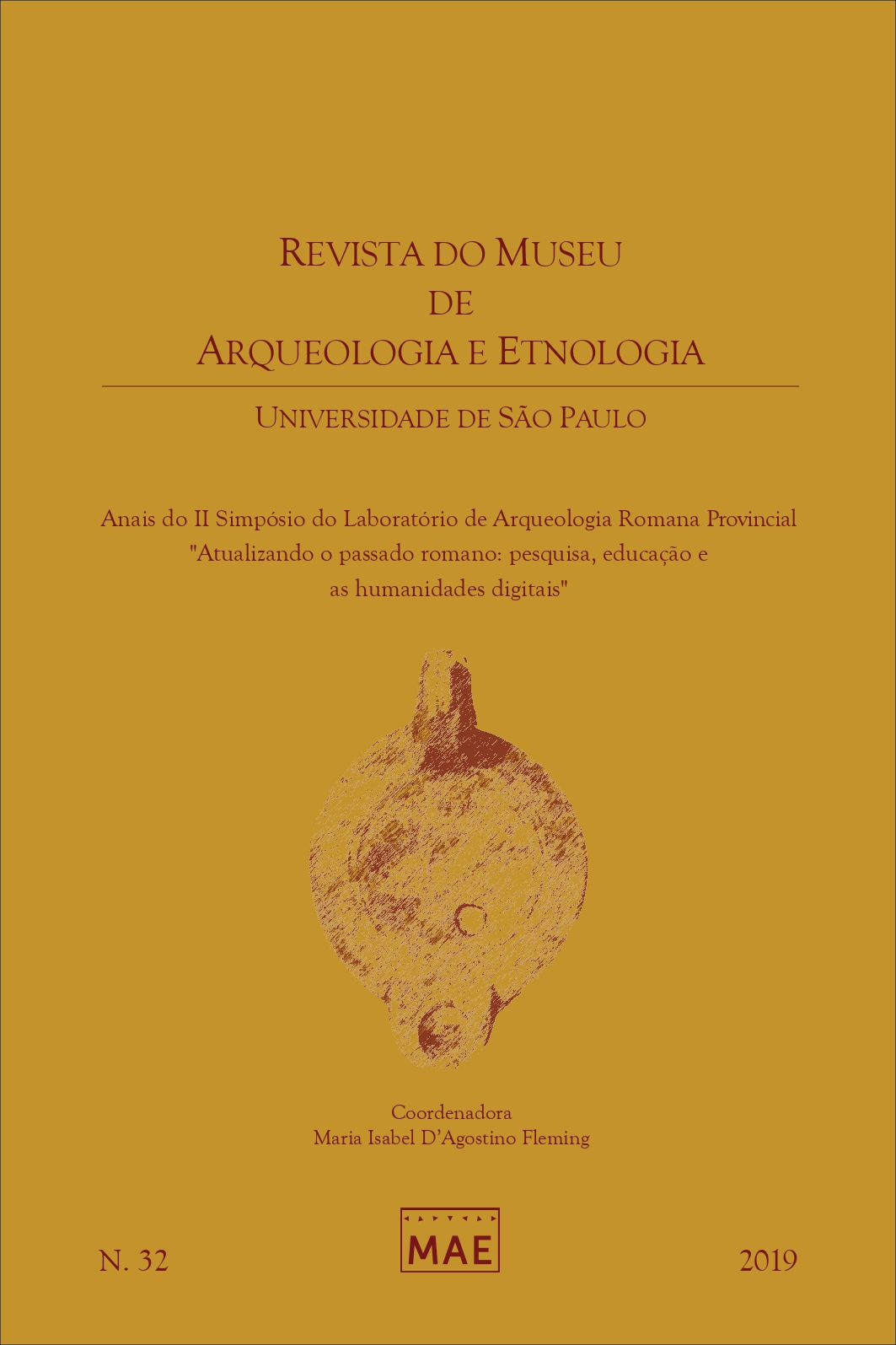The traceability concept and Roman North African ceramics
DOI:
https://doi.org/10.11606/issn.2448-1750.revmae.2019.164267Keywords:
African Roman pottery, Production, Consumption, Researches, Traceability conceptAbstract
Research on the Roman-African ceramic industry has had a very particular trajectory compared to that of other Mediterranean ceramics. A number of adverse factors were overcome in order to achieve consistent results concerning the modes of production and circulation in the African continent and the Mediterranean basin. Approaches that included new methodologies of progressive form faced the weak lithologic and sedimentological variability of the region and, consequently, very generic materials and little distinguishable from each other. These geological peculiarities make it extremely difficult to associate the archaeological (typological) and archaeometric (petrographic) treatment of the most recent surveys. Over the last two decades, the projects undertaken have been characterized by systematic cooperative work, with local teams (Tunisian, Libyan, Algerian) and foreign (French, Italian, English) teams conducting surveys of ceramic production sites, besides intensive archaeometric studies, with geochemical and petrographic analyzes. The latest archaeological documentation is sufficiently rich in information on the vitality of production and technology of Roman North American ceramics, sustained by economic growth and the mobility of workshops. These latest surveys are in line with the modern notion of traceability, much in vogue in the field of consumption. Applied to archaeological documentation, this notion implies effective labeling (i.e. an efficient typology), indication of a date of manufacture (presumed) and control of geographical origin, which are the only useful way to allow a good interpretation of the distribution of African goods. This paper aims to analyze the trajectory of research and the development of knowledge about the production and consumption of African ceramics in view of the most recent studies.
Downloads
References
Aguarod O. C. 1991. Cerámica romana importada de cocina en la Tarraconense. Institución Fernando el Católico, Saragosse.
Ahmed, M. A. M. 2010. Rural Settlement and economic Activity: Olive Oil and Amphorae Production on the Tarhuna Plateau during the Roman Period, Thèse de doctorat de l’Université de Leicester.
Ben Jerbania, I. 2013 – I. Observations sur les amphores de tradition punique d’après une nouvelle découverte près de Tunis. AntAfr, 49: 179–192.
Bonifay, M. 2007. Ceramic Production in Af¬rica During Late Antiquity: Continuity and Change. In: Lavan, L. & Zanini, E. (Eds.) Technology in Transition A.D. 300-650. Brill, Leiden: 143-158.
Bonifay, M. Tchernia, A. 2012. Les Réseaux de la Céramique Africaine (Ier-Ve siècles). In : Keay, S. (Ed.) Rome, Portus and the Mediterranean. Archaeological Monographs of The British School at Rome. London: 315-333.
Capelli, C.; Bonifay, M. 2014 Archéométrie et archéo¬logie des céramiques africaines: une approche pluridisciplinaire, 2. Nouvelles données sur la céramique culinaire et les amphores. LRCW 4. Late Roman Coarse Wares, Cooking Wares and Amphorae in the Mediterranean. Archaeology and Ar¬chaeometry. BAR–IS 2616 (I), Oxford: 235–253.
Capelli, C.; Bonifay, M. 2016 Archeologia e archeometria delle anfore dell’Africa romana. Nuovi dati e problemi aperti. In: Ferrandes, A. F.; Pardini, G. (Eds.) Le regole del gioco. Tracce Archeologi Racconti. Studi in onore di Clementina Panella. Roma: 535-557.
Capelli, C.; Leitch, V. 2011. A Roman amphora production site near Lepcis Magna: petrographic analyses of the fabrics. LibSt, 42: 69–72.
Cau Ontiveros, M. A.; Reynolds, P.; Bonifay, M. 2011. An initiative for the revision of late Ro¬man fine wares in the Mediterranean (c. AD 200–700): The Barcelona ICREA/ESF Work-shop. LRFW 1. Late Roman Fine Wares. Solving Problems of Typology and Chronology. A review of the Evidence, Debate and New Contexts (Roman and Late Antique Mediterranean Pottery 1), Oxford: 1–14.
Clay. T. 1992. Carthage et son commerce dans l’Antiquité tardive. In: Afrique du Nord Antique et Médievale, Spectacles, Vie Portuaire, Religions, Actes du Ve Colloque international sur l’Histoire et l’Archéologie de l’Afrique du Nord (Avignon, 9-13 avril 1990). Paris: 349-359.
Desanges, J.; Duval, N.; Lepelley, C.; Saint–Amans, S. 2010. Carte des routes et des cités de l’est de l’Africa à la fin de l’Antiquité (Bibliothèque de l’Antiquité tardive 17), Turnhout.
Estrabon. 2004. Geographie. Tome XV. Livre XVII, deuxième partie. L’Afrique de l’Atlantique au Golfe de Soloum. Les Belles Lettres, Paris.
Felici, F.; Pentiricci, M. 2002. Per una definizione delle dinamiche economiche e commerciali del territorio di Leptis Magna. AfrRom 14, Lo spazio marittimo del Mediterraneo occidentale: geografia storica ed economia, Roma: 1875–1900.
Ferrandes, A. F.; Pardini, G. (Eds.) 2016. Le regole del gioco. Tracce Archeologi Racconti. Studi in onore di Clementina Panella. Edizioni Quasar di Severino Tognon, Roma.
Ikäheimo, J. P. 2003. Late Roman African Cookware of the Palatine East Excavations, Rome. A holistic approach. BAR International Series 1143. Archaeopress. Publishers of British Archaeological Peports, Oxford.
Mackensen, M. 1993. Die spätantiken sigillata – und Lampentöpfereien von El Mahrine (Nordtu¬nesien). (Münchner Beiträge zur Vor – und Frühgeschichte, 50), Munich.
Nacef, J. 2015a. Production de la céramique antique in la région de Salakta et Ksour Essef, Tunisie (Roman and Late Antique Mediterranean Pottery 8), Oxford.
Nacef, J. 2015b. Un atelier de potier à la périphérie de la ville de Thapsus aux premiers siècles de l’Empire. AntAfr, 51: 2015:17–43.
Panella, C. 1993. Merci e scambi nel Mediterraneo tardoantico. In: Storia di Roma III, 2. Einaudi, Turim: 614-697.
Peacock, D. P. S.; Bejaoui, F.; Ben Lazreg, N. 1989. Roman amphora production in the Sahel region of Tunisia. In: Amphores romaines et histoire économique. Dix ans de recherche, Actes du colloque (Sienne, 22–24 mai 1986), (Collection de l’Ecole française de Rome 114), Rome: 179–222.
Peacock, D. P. S.; Bejaoui, F.; Ben Lazreg, N. 1990. Roman pottery production in central Tunisia. JRA, 3: 59–84.
Pline, L’Ancien. 2017. Histoire Naturelle. Vol. 5. Forgotten Books, Paris.
Pomponius Mela. 2017. Tome I. Len. Paris.
Salluste. 2002. La Guerre de Jugurtha. Classiques en Poche. Les Belles Lettres, Paris.
Ximenes, S.; Moerman, M. 1991. Le matériel archéologique de l’épave Laurons II (Martigues, Bouches-du-Rhône). Cahiers d’Archéologie Subaquatique, X: 209-222.
Downloads
Published
Issue
Section
License
Copyright (c) 2019 Maria Isabel D’Agostino Fleming

This work is licensed under a Creative Commons Attribution-NonCommercial-NoDerivatives 4.0 International License.













